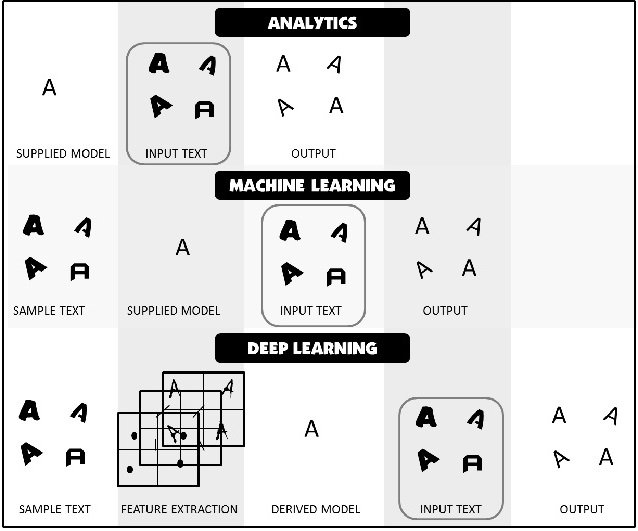
Styles of Deep Learning: What You Need to Know
Deep learning is an increasingly important part of the AI toolkit, yet it is often misunderstood.
- By Brian J. Dooley
- February 23, 2017
Deep learning is becoming an increasingly important part of the artificial intelligence (AI) toolkit, yet it is often misunderstood. Although it supports a developing market and is often touted as an important direction for corporate innovation, it needs to be viewed in context. This is a developing area of technology that is rapidly creating its own domain, becoming richer and increasingly varied. We will soon see new opportunities based specifically on deep learning.
The market for deep learning solutions continues to expand. According to one study, it will be worth $1.8 billion by 2022. It is part of the larger domain of AI but different enough to contain its own specific use cases and its own body of expertise.
Vive La Différence
Some have argued that deep learning is merely another term for machine learning, incorporating its most recent advances. In some ways this is true, but the advances created by the progress of machine learning algorithms have created a new type of cognitive platform.
Deep learning differs from ordinary machine learning by looking at hierarchical traits and trait networks as levels that can be subjected to independent but coordinated analysis. Deep learning applies neural net solutions to multilevel pattern recognition. It can be used to discover patterns independently, or as part of a supervised solution in which some initial modeling is supplied.
Image recognition provides a good example of how deep learning works in a highly generalized way. The basics are illustrated in Figure 1 below. If we look at the job of attempting to determine letters in the alphabet, an analytics solution would start with a model of each letter, then analyze how close images came to that model using a set of relatively simple formulae.
A neural net could perform the same task without layers in a supervised context, starting with a model and gauging through multiple iterations how each unknown character in a space best fit that model.
A deep neural network would be capable of viewing the space as a set of pixels on one level, linking the pixels to a next layer of abstracted line connections (edges), linking those lines to a next layer of features, linking those features to a next layer of feature sets, and so forth, until -- over many iterations -- it was able to determine alphabetical characters on its own.
It is this ability to independently analyze complex feature sets with relatively sparse advance modeling that sets deep learning apart and makes it increasingly important.

Figure 1: Simplified comparison of analytics, machine learning, and deep learning approaches.
The concepts involved in deep learning are expanding rapidly and new algorithms are constantly being devised. Its demonstrated success in fields such as vision and voice recognition has led to an explosion of interest and a growing variety of algorithms.
Different algorithms function better for different problems. Some are best used for image recognition, for example, others are more suitable for voice recognition, and yet others fall more in the domain of analytics and problem solving.
Variants of deep learning are rapidly expanding, but a good map of many variants can be found at http://www.asimovinstitute.org/neural-network-zoo/. These variants are based on different algorithms and are often combined to solve specific problems.
Deep learning can also be combined with other tools to form a more complete cognitive solution. The capabilities of deep learning continue to improve due to advancing algorithms as well as the continued progress of GPUs, available cloud resources, networks, and other infrastructure.
Fitting the Pieces Together
Deep learning does not replace the other elements of AI; it fortifies them by enhancing the capability to make local decisions -- particularly in situations demanding real-time analysis of patterned data, such as in robotics and in voice and facial recognition. With the continued development of these algorithms, the frontiers of immediate pattern recognition are being moved forward. This will have a continuing impact on sensory capabilities and voice/image identification.
We can also expect deep learning to be incorporated into other forms of analysis, such as big data, business analysis, predictive analytics, model-based analytics, and standard database searches or statistical analysis.
As with other areas of AI, deep learning will continue to benefit from new software and the continued expansion of related technology. Its development and use will demand new skills in the workplace and lead to a greater emphasis on AI capabilities. This will bolster trends which began with the focus on big data and Hadoop.
Incorporating analytics into ordinary business processes created enormous possibilities which are yielding advantages today. Incorporating AI and deep learning will move this to the next level.
[Editor's note: for an interesting infographic about deep learning, visit http://bjdooley.net/wp/singular-vision/2017/01/18/deep-learning-infographic/.]
About the Author
Brian J. Dooley is an author, analyst, and journalist with more than 30 years' experience in analyzing and writing about trends in IT. He has written six books, numerous user manuals, hundreds of reports, and more than 1,000 magazine features. You can contact the author at [email protected].